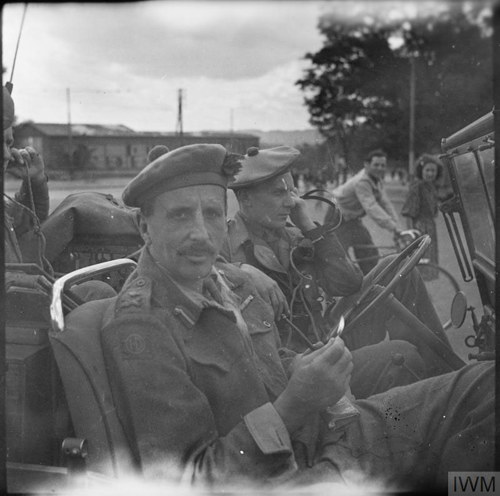24 March 2025
Legacy of Liberation: Crossing the Rhine & the Invasion of Germany
By March 1945, the Allies had pushed the Germans back over the River Rhine. Discover the story of the of the Invasion of Germany with Commonwealth War Graves.
Crossing the Rhine World War Two
Reichswald Forest War Cemetery

Image: Iconic white CWGC headstones marking the thousands of war graves at Reichswald Forest War Cemetery
Nearly 7,600 war graves lie in peaceful serenity in a beautiful clearing pitched beneath the dark boughs and branches of the stunning Reichswald Forest in the Reichswald Forest War Cemetery.
Those buried here lost their lives in the latter stages of the Second World War during the battles that saw the Allies finally break into Germany.
Some of those resting at Reichswald Forest died in the fighting there during the advance to the Rhine. Others died crossing that mighty river, while many airborne soldiers buried here were brought in from their earlier graves at Hamminklein.
The servicemen at Reichswald are a testament to the difficult, bitter fighting endured by the Allies in their attempts to cross the Rhine, invade Germany, and bring an end to the Second World War in Europe.
The military situation in Western Europe
By late 1944, France, parts of Belgium and the Southern Netherlands had been liberated from Nazi occupation.
The Allies had launched Operation Overlord at Normandy earlier in the year, captured Paris and crushed German resistance in France.
While they had faced significant setbacks at Arnhem during Operation Market Garden in mid-to-late September, momentum was still with the Allies. Key Belgian cities like Antwerp and Brussels had been liberated.
By November, the Canadian assault on the Scheldt had opened up further shipping lanes for Allied supplies.
Elsewhere, the first attacks on the Siegfried Line defences along the German border with The Netherlands, Belgium, Luxembourg, and France, had begun in August and by September the US Army was involved in a full-scale assault on the foreboding Hürtgern Forest in Germany itself.
However, even with the Germans being paired back on most European fronts, there was one major event that would delay the Allied invasion of Germany.
The Battle of the Bulge
 Image: A column of British troops marches through the snowbound Ardennes in the Battle of the Bulge
Image: A column of British troops marches through the snowbound Ardennes in the Battle of the Bulge
16 December 1944. As the fairy tale snows began to drape the verdant firs and broadleaves of the Ardennes in a glistening wintery blanket, something was stirring in the German sector.
With the ominous rumble of 1,400 tank engines resounding through the thick forests, the Wehrmacht smashed into US positions in the Ardennes, launching its last major offensive in the west: The Battle of the Bulge.
This last desperate roll of the dice by the Germans in the west temporarily threw the Allies into disarray. German armour threw itself mainly at the US positions around the Ardennes but failed to make a decisive breakthrough.
Although the Battle of the Bulge is remembered as a predominantly American battle, Commonwealth soldiers took part too. Some 55,000 British and Canadian soldiers fought in the battle’s latter stages, helping stymie the advance of the 2nd Panzer Division in the battle zone’s northern sector.
German losses at the Bulge were incredibly heavy, including substantial numbers of tanks and fighting vehicles destroyed.
Even so, orders from dictator Adolf Hitler demanded no retreat. The German military would fight fanatically to slow the Allied invasion of its homeland, despite the enormous cost.
The Battle of the Reichswald

Image: British Infantry advance through the Reichswald, Feb 1945 (© IWM)
With the Germans checked in the Ardennes, the Allies were able to clear the areas between the Mass and the Rhine rivers in what became known as the Battle of the Reichswald.
Also known as Operation Veritable, the Battle of the Reichswald began with a build-up of Commonwealth forces under British General Sir Bernard Montgomery before launching a massive bombardment of German positions.
The Germans were holding a defensive network known as the Siegfried Line. The Siegfried Line stretched along the Dutch-German border. It was bristling with bunkers, pillboxes, tank traps, machine-gun emplacements, and manned by now desperate Wehrmacht soldiers.
On the morning of February 8, 1945, a deafening chorus of artillery, mortars and Allied firepower rent the skies over the German border asunder with the largest Allied bombardment since El Alamein in November 1942.
The fighting in the sinister Reichswald was heavy, bitter, and bloody but by March, the Allies had broken through in the wide flood plains of the Rhine Valley.
Private James Stokes VC
 Image: Private James Stokes (copyright unknown)
Image: Private James Stokes (copyright unknown)
During the fighting on 1 March 1945, Private James Stokes of the 2nd Battalion, King’s Shropshire Light infantry, had single-handedly rushed multiple German positions, killing or capturing their defenders.
James showed an incredible lack of self-preservation in the face of duty. He was wounded no less than eight times during the swirling combat of the Battle of the Reichswald.
In his final attempt to rush another German strong point, James was finally cut down and killed.
For his magnificent courage in the face of enemy fire and devotion to duty, James was posthumously awarded the Victoria Cross.
James, who was 30 years old at the time of his death, now lies in Reichswald Forest War Cemetery.
Major Ronald Edmond Balfour
 Image: Major Ronald Edmond Balfour (copyright unknown)
Image: Major Ronald Edmond Balfour (copyright unknown)
Clearing the Reichswald brought Commonwealth forces into the flooded plains on the left bank of the Rhine.
In their way lay the famous medieval town of Kleve, a site of major cultural and historical significance full of relics and artefacts of Germany’s storied past.
Major Ronald Balfour, a 41-year-old medieval historian and fellow of King’s College, Cambridge, was killed by shellfire on March 10 during the attack on Kleve.
Ronald was a member of the Monuments, Fine Arts and Archives Section, Supreme Headquarters Allied Expeditionary Force.
Known as the “Monuments Men”, this unit's job was to, wherever possible, rescue any relics and items of artistic and cultural significance from Allied target locations.
Ronald was killed performing this important duty, to help preserve Kleve’s lengthy past.
Operation Plunder
“Over the Rhine, then, let us go. And good hunting to you all on the other side.” – Field Marshal Sir Bernard Montgomery in his message to 21st Army Group, March 1945
The mighty river Rhine was one of the key obstacles facing the Allies in the invasion of Germany.
A wide, fast-coursing natural barrier, the Rhine was further reinforced by German defensive positions. Crossing it would be no mean feat for the Commonwealth forces under Field Marshal Montgomery.
Opposed river crossings are one of the most difficult, dangerous tasks an army can face. With US troops having captured the Rhine bridge at Remagen to the south of Commonwealth positions, Monty was leaving nothing to chance.
The Field Marshal was once again meticulous in his preparation, greatly building his forces to ensure overwhelming superiority in numbers and firepower. Under his command was the 21st Army Group, a multinational force made up of British, Canadian, American, Polish, Dutch, Belgian and Czech units.
The Rhine assault was given the codename Operation Plunder.
Over 250,000 tons of supplies were stockpiled for 21st Army Group in the weeks leading up to Plunder. Veteran formations were brought in too and troops were put through further training.
A prodigious proportion of artillery was amassed too, numbering some 5,500 British and American guns. The guns and infantry were backed up by thousands of tanks and fighting vehicles, including amphibious tanks, while landing craft were brought in from the coast.

Image: British troops exit their amphibious vehicles having successfully crossed the Rhine (© IWM)
As the build-up on the ground gained traction, Allied air forces used their aerial supremacy to target German defenders and their communication networks, cutting them off from reinforcement.
On 23 March at 17:00, another sky-shattering bombardment heralded the Allied attack. Artillery fire was rained down on German positions on the far side of the Rhine.
At the spearhead were men of the 51st Highland Division. At 21:00, riding in Buffalo amphibious vehicles, protected by a smokescreen and supported by amphibious tanks, the Highlanders hit the waters opposite the historic town of Rees.
Initial resistance was light, the defenders paralyzed by the shock and ferocity of the Allied assault. By first light, the Highlanders had entered Rees.

Want more stories like this delivered directly to your inbox? Sign up for our newsletter for regular updates on the work of Commonwealth War Graves, blogs, event news, and more.
Sign UpMarine Leonard George Rider

Image: British tanks and infantry advance through the smashed streets of Kleve (© IWM)
Further along the river, the men of the elite 1st Commando Brigade began crossing downstream of the city at Wesel. This was the centre of the Allied attack and soon RAF bombers arrived, dropping some 1,100 tons of explosives.
Wessel was nearly obliterated. The city was devastated to such a degree that the maps handed to the Commandos were nearly useless. Streets and buildings had been pulverised into a tangled mess of blasted ruins.
Moving their way through the rubble, the Commandos were able to outflank and attack surviving Wehrmacht defenders from the rear.
During the battle, Marine Leonard Rider, a docker from East London, was cut down and killed alongside his comrade Marine Sam Durose.
Sam and Leonard lie together in the same grave at Reichswald Forest War Cemetery, spending eternity side-by-side, reflecting how they fought and fell together.
At 02.00 in the early morning of 24 March, the 15th (Scottish) Infantry Division crossed the Rhine at Xanten, landing between Wesel and Rees at the same time the US divisions began their attacks further south.
Opposition to the Scots was mixed. In some areas, defenders were swept away by the superior Allied firepower. Other positions, especially those held by the fallschirmjäger of the 7th Parachute Division, proved harder to crack.
With the skies lightening across the Rhine, many of Operation Plunders’ day-one objectives were still being fought over.
Major-General Tom Rennie
 Image: Major-General Tom Rennie (© IWM)
Image: Major-General Tom Rennie (© IWM)
At dawn of the 24th, the 51st Highlanders with support from the 9th Canadian Brigade, captured Rees’ historic church but the situation was still mixed along the Allied bridgehead.
Some Commonwealth units had made a rapid advance, sweeping away resistance, taking prisoners and ground with ease. Elsewhere, soldiers clashed with fanatical German troops refusing to retreat.
In some cases, the Commonwealth soldiers were holding off desperate Wehrmacht counterattacks.
The 51st Highlanders’ commander, Major-General Tom Rennie, crossed the river to assess the situation. Rennie was a highly experienced soldier. He had been captured earlier in the war during the Battle of France but managed to escape, returning to serve in North Africa, Sicily and Normandy.
As Rennie dismounted his jeep, a German mortar landed close by, killing the 45-year-old general. He is buried alongside his men in Reichswald Forest War Cemetery.
Operation Varsity

Image: Glider troops wait next to their Jeeps waiting to move off once more during Operation Varsity (copyright unknown)
Shortly before 10.00, the thunderous roar of Allied artillery went silent, only to be replaced by the deafening drone of thousands of Allied aircraft.
1,500 transport planes and 1,300 gliders appeared over the battlefield carrying 17,000 British and American paratroopers and airborne soldiers, heralding the start of Operation Varsity: the airborne component of the Allied Rhine Crossings.
As they had done at Normandy, and attempted at Arnhem, the airborne soldiers dropped behind enemy lines and began causing havoc. The paras captured several important crossings along the River Issel, disabled enemy artillery, and cut enemy communications.
Learning from the disaster at Arnhem, the paras were dropped close enough to Allied positions that they began to link up with ground forces by that afternoon.
However, the Airborne were still subject to heavy casualties as they battled to take their objectives and hold them against enemy counterattack.
Private John William Riddell
 Image: Private John William Riddell (copyright unknown)
Image: Private John William Riddell (copyright unknown)
Amongst the paras battling hard to hold their targets was Private John William Riddell of 8th Battalion, the Parachute Regiment.
Born in Nuneaton, Warwickshire, John had been a bricklayer in civilian life before enlisting in the Warwickshire Regiment in 1942. He later volunteered for the Parachute Regiment and saw action in Normandy.
Sadly, John did not survive the war. He was killed, aged 22, near Hamminkein. He is buried along with his comrades in Reichswald Forest War Cemetery.
Thanks to the titanic effort and sacrifice of men like John, resistance west of the Issel was over by nightfall. German counterattacks had been stopped dead. The isolated bridgeheads along the river were beginning to link up.
Pushing into Germany
On the morning of 25 March 1945, having endured and defeated Wehrmacht counterattacks throughout the night, the Allies began to expand their bridgeheads into a cohesive front.
Further Allied formations, including armoured divisions, were now crossing the Rhine in force. Although they encountered sporadic resistance, the attack over the Rhine had established a bridgehead some 30 miles wide by 20 miles deep.
With German resistance virtually collapsed, Allied forces split off into three main army groups:
- The Canadians turned north into the Netherlands
- The US turned east in the Ruhr Valley
- The British turned northeast towards the German coast
Roughly a month after Operation Plunder, German Dictator Adolf Hitler committed suicide in his Berlin command bunker. Meanwhile, Red Army troops of the Soviet Union had surrounded, bombarded, and occupied the German capital, causing untold devastation to its beleaguered defenders.
The German Armies in the West had been shattered, but invading Germany would still present many dangers for the Allies.
The remaining defenders were either being forced to defend their homes or were some of the most fanatical soldiers of the German military. It would not be easy.
Serjeant Egon Vogel (served as Ernest Robert Viliers)
Egon Vogel was born into a Jewish family in Hamburg, Germany, on 7 September 1918.
Egon made his way to Britain as a young man, likely in the late 1930s following the Rise of Hitler and the Nazis and the increasing oppression and violence against Germany’s Jewish population.
Settling in London, Egon worked as a trainee plater for Mr T.G. Jones in Wood Lane, Shepherd’s Bush.
At the beginning of the Second World War, only a few “enemy aliens”, i.e. people considered to be citizens of countries at war with Britain.
Egon was initially deemed not a threat by British authorities, but following the panic caused by the Fall of France in 1940, Egon was interred in June.
In July, Egon and 2,500 internees, mostly German and Italian “aliens”, many of them Jewish, were transported to Australia onboard the SS Dunera.
Their treatment aboard Dunera was shocking and deplorable. The British guards beat and abused the prisoners. Many of the internees’ possessions were stolen or thrown overboard.
After a gruelling two months at sea, they finally reached Australia. Their treatment was so bad that the British Government was forced to compensate the passengers after their trying ordeal.
Despite everything he’d endured so far, Egon still wanted to do his bit for the war effort. He was selected for service with the Commandos: the elite special forces of the British military.
He joined No.3 Troop of No.10 (Inter-Allied) Commando, sometimes referred to as “X Troop”.

Image: 3 Troop No 10 Inter-Allied Commando, 1943 with Egon circled (copyright unknown)
X Troop was recruited mostly from the same “enemy aliens” the government had previously interred, mostly German, Austrian, or Eastern European Jews, often selected for their language skills.
In addition to the rigorous training all Commandos went through, X Troopers were given additional schooling in intelligence work as they were to act as interpreters and interrogators attached to other units.
Each X Troop recruit assumed an English “Nomme du Guerre”, a literal name of war, and listed British friends as their next of kin to hide their origins in case of capture by the Nazis.
Thus, the German Jewish Egon Vogel became the British Christian Ernest Robert Villiers.
Egon was promoted to Serjeant and served in the D-Day landings in June 1944. In Normandy, Egon was wounded in combat.
Following his recovery, Egon saw action again during Operation Plunder, serving with 46 Royal Marine Commando.
46 Commando crossed the Rhine on the night of March 23, 1945, downstream from Wessel.
It is believed that Egon was wounded during an incident which killed two other marines, Marines Leonard Rider and Sam Durose, while trying to outflank Wesel. Egon was evacuated for medical treatment but died the following day.
He was 25 years old.
WW2 Casualties of the Rhine Crossing
The Crossing of the Rhine and the operations in the run-up cost the Commonwealth tens of thousands of casualties.
Operation Veritable, the campaign to clear the Reichswald, cost 21st Army Group over 20,000 British and Canadian officers and enlisted men.
Operation Varsity resulted in the loss of around 1,400 or so personnel. For context, the British 6th Airborne Division deployed around 7,220 paratroopers for Varsity.
The main crossing, aka Operation Plunder, actually resulted in comparatively small casualties, given the size of the force wielded by Montgomery for the Rhine assault.
4,000 Commonwealth soldiers lost their lives in the battles to cross the Rhine. A further 2,800 American soldiers were killed alongside them.
Discover the Legacy of Liberation
The Legacy of Liberation continues this year.
2025 marks the 80th Anniversary of VE Day and VJ-Day and the end of the Second World War.
Join us for events, blogs, and virtual tours that help tell the story of the final months of this world-changing conflict, and how the work of the Commonwealth War Graves Commission hasn’t stopped since then.

